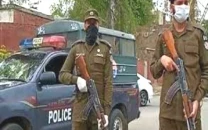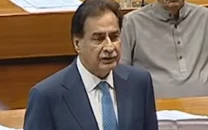Pakistan successful in ousting militants, now rebuilding tribal regions, reports US newspaper
Islamabad says life returning to troubled area, as Washington asks country to 'do more' against terrorists

A vacant lot, leveled during the two-year Pakistani offensive against the Haqqani network lies dormant in the North Waziristan city of Miran Shah. Small placards indicate the property’s ownership claims, should they return to the provincial capital. PHOTO COURTESY: THE WASHINGTON TIMES
According to the US-based publication, this is an image paid for with blood and treasure in a two-year campaign by the Pakistan Army to clear North Waziristan’s provincial capital from groups such as the Pakistani Taliban and the infamous Haqqani network.
But the new schools, homes and markets, with their glistening coats of paint and freshly poured concrete, mask a seeming ghost town, the article, published on Sunday, suggests.
Few residents of the largest city in North Waziristan rarely venture into the heart of the city center - the site of the some of the most intense clashes with radical militant groups that refuse to go away.
The fighting had become so intense at the onset of the operation that the military was forced to evacuate thousands of civilians into “temporary displaced persons” camps elsewhere within the country and the Federally Administered Tribal Areas (FATA).
From high atop Sarbanki Fort, one of several Pakistani army outposts manned by units from the “Golden Arrows” 7th Division, Brig Gen Jawad proudly pointed out for a small group of visiting reporters the burgeoning skyline of markets, schools, homes and businesses that cover a wide swath of Miran Shah’s new city center.
Rs33b needed to rebuild tribal areas
When asked what happened to the homes and businesses that stood in their place before the government offensive into North Waziristan, Gen Jawad replied dispassionately, “They were no more. Wiped away clean.”
In the two years since the official end of the North Waziristan operation, Islamabad claims life has slowly returned to Miran Shah and the surrounding provinces, despite continuing complaints from the Trump administration that Pakistan is not going enough to root out extremist groups that use the border regions as a sanctuary, training base and launching pad for attacks inside Afghanistan.
Maj Gen Azhar Ali Shah, head of all 7th Division forces in North Waziristan, said in a briefing that he has “taken a back seat” to Pakistani military and civilian-led redevelopment operations in Miran Shah, one of the largest cities in the Federally Administered Tribal Areas.
“In this whole area, I do not have any enemies,” he told The Washington Times.
Another fresh sign of progress is that the country on March 10 announced the reopening of a key Ghulam Khan border post between the North Waziristan tribal region and Afghanistan, allowing for trade convoys to pass.
The crossing was closed for three years after government forces launched a major operation against the Pakistani Taliban and foreign militants in the area.
Brick by brick: Tribespeople demand rebuilding of education infrastructure
Radical links
Despite Pakistan’s public pronouncements, many US officials contend the country maintains long-standing links to radical groups as a lever to pressure Kabul and as an asset in Islamabad’s rivalry with its greatest strategic challenge: India.
But Gen Azhar said his country’s contributions and sufferings from the global war on terror, some with roots in the US-backed war against the Soviet Union in Afghanistan in the 1980s, have been consistently overlooked by Washington and other foreign critics.
"Over 800 Pakistani soldiers embraced martyrdom and 3,500 were wounded in the operation to flush out extremist groups from their redoubts in North Waziristan," he said.
In a thinly veiled shot at the American-led efforts to battle the Afghan Taliban, Gen Azhar said his forces were able in two years to subdue the de facto center of the Haqqani network, a brutal Afghan militant group headed by warlord Sirajuddin Haqqani, while the US-backed Afghan forces could not do the same across the border.
Pakistan accomplished this without alienating the local population, which is critical to winning a guerrilla struggle.
“We did not fight the population; we [only] fought the terrorists,” he said.
But that success has come at a cost that is evident from a quick survey of the landscape.
Five-year plan: Fata schools to be rebuilt on priority
Bombed-out plots of land that once housed local businesses lay in tatters, as do mud-brick compounds that housed generations of Waziri families. Trash and debris line the newly paved roads that cross the former Haqqani stronghold.
Small black placards baking in the sun, erected by 7th Division troops, list the family names of those who owned the shops and homes, waiting for them to reclaim their property.
Those who have stuck it out agree with Gen Azhar’s contention that the most dangerous place on earth has turned a corner.
Clad in a leather jacket over a traditional shalwar kameez, teacher Arif Ula recalled the days when his high school - located yards from a Pakistani combat outpost in the city center - was used as a mortar pit by Haqqani fighters during some of the most intense battles of the North Waziristan offensive.
“It was very bad, very dangerous,” he said in an interview, recalling the dilapidated school where he conducted classes during lulls in the fighting.
Arif, who has a PhD in early childhood education and earned his master’s degree at California State University-Chico, recalled the day Pakistani forces moved his family from Miran Shah to a camp 80 miles north in the Swat Valley - a former Pakistani Taliban stronghold cleared months before the North Waziristan operation reached full swing.
“We were sad. We did not want to go” despite the violence, Arif said.
“It was very far, and [Miran Shah] is our home.”
But despite those hardships, staying in Miran Shah under the Haqqanis and Pakistani Taliban was not an option, he said.
“Things were very bad with them,” he said. “It was terrible. We could not live like that anymore.”
Teaching elementary and high school students at the new school built by the 7th Division on the site that was once a Haqqani mortar and artillery pit, Arif declares, “It is good to be home.”
Victory against militants
In the war that straddles the Pakistan-Afghanistan border, from Swat Valley in the northwestern Pakistan to Balochistan province bordering the Taliban heartland of Helmand and Kandahar provinces in Afghanistan, defining success has often been as complicated as determining which warring factions were fighting whom.
To Islamabad, the costly campaign carried out in North Waziristan, Balochistan and the Swat Valley is proof positive that Pakistan does not differentiate between good and bad groups.
“We do [counterterrorism] across the board,” said Maj Gen Nadeem Ahmed Anjum, inspector general for Pakistan’s Frontier Corps for Balochistan province, citing the more than 2,500 counterterrorism operations his units have executed in the past year.
“We do not discriminate between Haqqani [Network], Tehrik-e-Taliban - the Pakistani Taliban faction - and Lashkar-e-Taiba,” the terrorist group responsible for the 2008 attacks in Mumbai, he said during an interview at his headquarters in Quetta.
“Pakistan has to put on a good show” given the international pressures it faces, said Bill Roggio, senior fellow of the Foundation for Defense of Democracies.
On the North Waziristan operation, “if the [terrorist groups] were anti-state, they went after you,” he said.
Sedney said it appeared the 7th Division was able to flush Haqqani network fighters from the border areas in North Waziristan, but Gen Azhar’s claims of the group’s demise were flat wrong.
“Is there a Haqqani headquarters in Miran Shah? No,” Sedney said.
“But it is clear the Haqqanis continue to operate out of the Kurram Agency,” he added.
The Kurram Agency is a largely Pashtun tribal area on the northern border that is the closest part of the country to the Afghan capital of Kabul.
Several American drone strikes have reportedly targeted top Haqqani leaders in Kurram Agency.
In Islamabad, Maj Gen Asif Ghafoor, director general for the Inter Services Public Relations, acknowledged that Pakistani intelligence and the CIA had exchanged information that led to “intelligence-based operations” in the tribal areas. But he would not provide details about the operations or the targets.
This article originally appeared on The Washington Times


















COMMENTS
Comments are moderated and generally will be posted if they are on-topic and not abusive.
For more information, please see our Comments FAQ